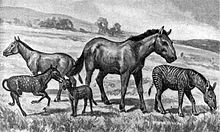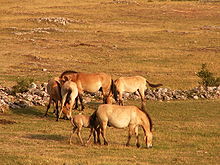en
names in breadcrumbs


Perception Channels: tactile ; chemical
Other Physical Features: endothermic ; bilateral symmetry
Key Reproductive Features: gonochoric/gonochoristic/dioecious (sexes separate); sexual
Diversity of Living Equids
The mammal families Equidae (horses), Tapiridae (tapirs), and Rhinocerotidae (rhinoceroses) together comprise the order Perissodactyla (the odd-toed ungulates). Equidae includes just seven species, all placed in a single genus, Equus. Zebras (which have stripes) live on the savannas and bush-woodlands of Africa; asses (which are dark on top and pale under the belly) inhabit deserts from the Horn of Africa across the Middle East to the mountains of Asia; and horses (which have mostly uniform coat color) live in the temperate grasslands of North America, Eastern Europe, and Central Asia. These three groups apparently represent clades, but uncertainties in equid phylogeny remain.
The earliest equids are believed to have evolved in North America more than 50 million years ago, but migration brought equids to Europe, South America, and Asia. Based on fossil analysis, equid diversity by the end of the Miocene (~5 million years ago) included more than a dozen genera, but as a result of lineage extinction since then, all extant equids are placed in the single genus Equus. The caballines or ("true horses") include the domesticated and feral horse (E. caballus), which is believed to be derived from the wild Tarpan lineage, and the wild Przewalki's Horse (E. przewalskii). The non-caballines include the (a) hemionines or hemiones (Asiatic Wild Ass, E. hemionus, and Tibetan Wild Ass, E. kiang), (b) African Wild Ass (E. africanus), (c) the ancestor of the domesticated donkey (E. asinus), and (d) the African Zebras (the Plains Zebra, E. quagga, with its many subspecies including the extinct Quagga, E. quagga quagga; the Mountain Zebra, E. zebra; and Grevy's Zebra, E. grevyi). For a phylogenetic analysis of relationships among living equids based on complete mitochondrial DNA (mtDNA) sequences, see Vilstrup (2013). Steiner et al. (2012) came to largely concordant conclusions based on their analysis of partial mtDNA and nuclear DNA sequences. In North America, horses went extinct by around 12,000 years ago--until domestic horses were reintroduced by European explorers; feral descendants of these horses are now well established in parts of the western United States.
Equid Morphology
Horses have long-haired tails and long manes that fall to one side of the neck in domestic horses. A characteristic anatomical feature is the presence of chestnuts (chestnuts are callosities on the inner side of the leg above the knee on the foreleg and, in horses but not in asses and zebras, below the hock on the hindleg.). The three species of zebras have distinct stripe patterns: The stripes of Plains Zebras are broad and touch underneath the belly; the stripes of Grevy's Zebras are thin and do not meet underneath the belly; the stripes of Mountain Zebras are intermediate in width and also do not meet underneath the belly. Grevy's Zebras have a white rump at the base of the tail, whereasMountain Zebras have a "waffle iron" pattern on the back near the base of the tail. The head of Grevy's Zebras is relatively larger than that of other zebras, with an elongated face, and its large rounded ears can be rotated independently in different directions.
Equid Ecology and Behavior
All equids live in open habitats, whether temperate grassland (horses), African savanna (zebras), or hot and sandy or high elevation cold and stony deserts (asses).
Equids are active both during the day and at night and spend a large portion of their time foraging. Equids are mainly grazers. They are able to eat tough, fibrous vegetation, often laden with silica crystals. As hind-gut fermenters, they do not process food as efficiently as ruminants and must therefore consume larger volumes. Equids sleep in short bouts, usually while standing (anatomical innovations in both their front and rear legs allow them to sleep without collapsing).
Equids are gregarious animals with complex social interactions. They form groups ranging from tens to many hundreds of individuals. They are unusual among mammals in that juveniles of both sexes disperse when they mature. There are two basic types of equid social structures. In the first type, which characterizes horses as well as Plains and Mountain Zebras, females and their young offspring live in small family groups with a single male. These groups range widely and mating in these groups involves multiple females mating with a single male. In the second type of social structure, which characterizes Grevy's Zebras as well as African, Asiatic, and Tibetan Wild Asses, associations among adult males and females are transitory, sometimes lasting just a few hours. Males establish resource-based territories that allow them to associate with many females for as long as they remain in the male's exclusive area. In this case, both males and females have multiple mates. For this second type of social system, the only persistent bonds are between females and their young offspring. In both types of social systems, many males are not able to associate with females and form bachelor groups.
Equids and Humans
The relationship between humans and equids goes back thousands of years. Neolithic drawings of horses, some dating back 20,000 years, cover the walls of caves in Italy, France, and northern Spain. When humans reached the New World, the naïve horses there were no match for the humans hunting them and they were eradicated over a period of several hundred years, with entire herds sometimes stampeded over cliffs. European explorers later brought horses back to North America. Feral populations of domestic horses are now present in North and South America, Europe, New Zealand, Australia, and on many oceanic islands. Horses were domesticated by nomads on the Asian Steppe around 4000 years ago, placing them among the first animals domesticated by humans. Over the millenia, hundreds of breeds of horses and donkeys have been bred for various uses (e.g., Belgians and Clydesdales for pulling heavy loads, Percherons to carry knights in heavy armor, Thouroughbreds for racing, Quarter Horses to help herd cattle, and mules [the cross between a female horse and a male donkey] for use as tough and sure-footed pack animals). The domestication of horses made the work of transporting people and goods as well as farming much easier. The domestication of the wild ass and subsequent cross-breeding of donkeys with horses yielded hybrids such as mules that were even stronger and tougher than their progenitors. In addition to make life easier for people, however, the domestication of horses facilitated war and social inequality. Curiously, zebras were never domesticated, although they were sometimes tamed and used to draw chariots and carriages for show. It is possible that zebras exhibit too much aggression in their social interactions to be good candidates for domestication.
Equid Conservation Status
In areas with dense human populations, such as the Near East, North Africa, and Western Europe, wild horses were driven to extinction in early historical times. They persisted until late historical times in many parts of Eastern Europe and western Asia. Forest populations persisted until 1814 in Latvia and until the early 19th century in Poland. Steppe populations persisted a bit longer: the last known wild Tarpan was killed in December 1879 in the Tavrichesky steppe, near Askania-Nova, Ukraine. An individual caught near Kherson lived in the Moscow Zoological Park until the 1880s. Captive-bred animals were maintained on stud farms, but the last Tarpan of wild stock died in 1918.
The Plains Zebra subspecies known as the Quagga, which was once distributed in southern South Africa, was extinct by around 1883. Przewalski's Horse, which likely once roamed the steppes of China and central Asia, became extinct in the wild, with the last known free-roaming individual observed in the Dzungarian Gobi in Mongolia in 1969. Reintroduction efforts using captive bred Przewalski's Horses have met with some success in Mongolia and China. Grevy's Zebra and the African and Asiatic Wild Asses are endangered. Mountain Zebras are vulnerable. The Tibetan Wild Ass—the only equid that typically lives for part of the year above 5000 m—is poorly known, but populations are believed to be stable, as are Plains Zebras over much of their range.
Equidae (sometimes known as the horse family) is the taxonomic family of horses and related animals, including the extant horses, asses, and zebras, and many other species known only from fossils. The family evolved around 50 million years ago from a small, multi-toed ungulate into larger, single-toed animals. All extant species are in the genus Equus, which originated in North America. Equidae belongs to the order Perissodactyla, which includes the extant tapirs and rhinoceros, and several extinct families.
The term equid refers to any member of this family, including any equine.

The oldest known fossils assigned to Equidae were found in North America, and date from the early Eocene epoch, 54 million years ago. They were once assigned to the genus Hyracotherium, but the type species of that genus is now regarded as a palaeothere. The other species have been split off into different genera. These early equids were fox-sized animals with three toes on the hind feet, and four on the front feet. They were herbivorous browsers on relatively soft plants, and already adapted for running. The complexity of their brains suggest that they already were alert and intelligent animals.[2] Later species reduced the number of toes, and developed teeth more suited for grinding up grasses and other tough plant food.
The equids, like other perissodactyls, are hindgut fermenters. They have evolved specialized teeth that cut and shear tough plant matter to accommodate their fibrous diet.[3] Their seemingly inefficient digestion strategy is a result of their size at the time of its evolution,[4] as they would have already had to be relatively large mammals to be supported on such a strategy.
The family became relatively diverse during the Miocene epoch, with many new species appearing. By this time, equids were more truly horse like, having developed the typical body shape of the modern animals.[5] Many of these species bore the main weight of their bodies on their central third toe, with the others becoming reduced and barely touching the ground, if at all. The sole surviving genus, Equus, had evolved by the early Pleistocene epoch, and spread rapidly through the world.[6]

Equidae (sometimes known as the horse family) is the taxonomic family of horses and related animals, including the extant horses, asses, and zebras, and many other species known only from fossils. The family evolved around 50 million years ago from a small, multi-toed ungulate into larger, single-toed animals. All extant species are in the genus Equus, which originated in North America. Equidae belongs to the order Perissodactyla, which includes the extant tapirs and rhinoceros, and several extinct families.
The term equid refers to any member of this family, including any equine.